- 651-738-1880
- 8380 City Centre Drive, Suite 130 Woodbury MN 55125-5304
My father who has been practicing dentistry for 60 years had a saying he shared with me early in my dental career: “To have satisfaction with your profession you need to get paid twice”.
At the time, I didn’t really understand what he meant by the second pay. I realized he meant you needed to get paid monetarily but at the time I didn’t grasp what the second pay was. But as my career in dentistry slowly matured, it dawned on me the second pay was actually the most important pay. It was the job satisfaction of knowing you created a “world class” dental restoration for the patient plus knowing they were really happy with what you had done for them.
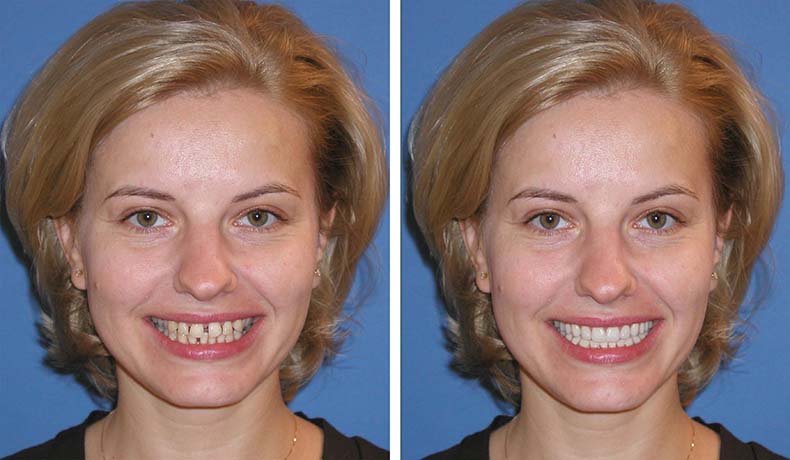
Figures 1 & 2 – Pre-op photos before orthodontics.
For example, early in my esthetic dentistry journey I remember completing upper anterior restorations for a patient that I spent countless hours on. At the end of the appointment I handed them the mirror and to my dismay I saw the look of disappointment. It was a crushing feeling that all my hard work wasn’t appreciated by them. Then I found myself in the position to explain why I designed the restorations the way I did. At the end it only sounded like excuses and I lost the battle. I had no choice but to offer to start over (for free of course). And even though I was offering to re-do the work neither one of us left that day feeling good. Resulting in disappointment verses what should have been a great celebration. And the second pay my father was talking about definitely didn’t happen.
Fortunately, I have slowly come a long way in this journey of esthetic dentistry. I have learned that anterior dentistry, cosmetic dentistry or esthetic dentistry doesn’t have to be so stressful and unpredictable. In this article I will walk you through a case example in which you will learn a systematic approach to predictable outcomes. There will be seven key steps where you will be involved with designing the esthetics and function of the case. Four of the steps the patient will have the opportunity to give input and approve the look of the case. So at the delivery appointment when handed a mirror your patient will say “That looks great! That is exactly what I expected”. And you will probably get a hug too. It’s results like this that really makes esthetic dentistry fun and amazingly rewarding.
A 43-year-old male reported not liking the chipping that was happening to his front teeth. He also commented he had chewing sensitivity with his lower back molars. He was slightly aware of waking up with tension with his facial muscles. His wish was to have a nice natural looking smile that wasn’t chipping and to be able to chew on his back teeth without pain.
I schedule 30 minutes for this appointment. I feel this is one of the most important steps to this whole process. Dr. LD Pankey once said: “Don’t treat a stranger”. 2 I find it more rewarding to work with people I know well and if you are meeting a new patient this is great opportunity. Not only will you get to know them as a person but you will begin to learn what personality type they are and will communicate with them more effectively.2 This is the time to listen to all their concerns and to find out what they don’t like about the appearance of their teeth. I like to ask the simple question: “If you could wave a magic wand what would you like to change with the appearance of your teeth”. Then try to be quiet and let them educate you about what they want and what their expectations are. These comments will be the foundation of your entire esthetic treatment plan. You may even find out that you are unable to meet their expectations. 1
The patient featured in this article had expectations to have healthy, clean and natural looking teeth with no spaces and to achieve this with conservative restorative dental care.
If you have concluded that you can most likely meet or exceed their expectations then like any good diagnosis you will need the following diagnostic records:
– Review medical history
– Dental/ Occlusal/TMJ exam
– Periodontal exam- full mouth pocket charting
– Complete radiographic series (FMX)
– AACD photographic series (12 views)3
Mounted models- facebow transfer, centric relation bite registration and a horizontal bite stick Trubyte denture face measurement template
When you take the facebow transfer make sure you level the facebow to the horizontal axis of their face. The horizontal bite stick will be your backup to verify the models were mounted to the horizontal axis. If the patient has a canted occlusion you will be able to visualize this with properly mounted models. In Figs 1 and 2 you will see she is slightly lower on her left side.
To achieve the desired results the treatment plan involved starting first with orthodontics. In most esthetic or complex restorative care, orthodontics is usually recommended. In this patient’s case she had large spaces with teeth a little smaller than her ideal proportion, deep overbite with lower anteriors biting into her palate and her buccal corridor was collapsed on her left and right (figs. 1,2 and 18). If the teeth were restored in their current position a full mouth reconstruction with full crowns would have to be treatment planned vs conservative veneers and onlays on less teeth. Since the patient requested a conservative approach, an option presenting a lower risk of tooth morbidity and periodontal issues and a lower cost would be well received.
After the completion of the more urgent posterior restorative care the orthodontic and anterior restorative treatment plan was as follows:
Begin with full upper and lower braces involving a 24 month treatment plan with the following goals:
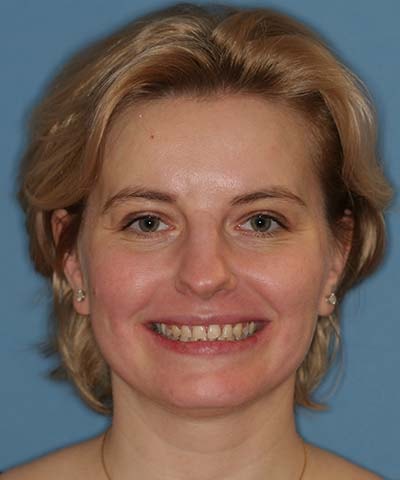
Pre-op photos after orthodontics: Note the improved space distribution, overbite, buccal corridor development and axial inclination of the incisors.
• Create the proper spacing for the veneers.
• Bring out the left and right buccal corridor.
• Level the occlusion and correct the deep overbite.
• Improve the axial inclination of her teeth.
The subsequent restorative treatment plan involved the following:
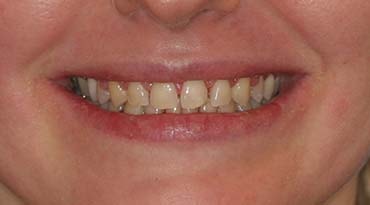
Lower arch:
• Teeth ## 21 and 28: IPS e-max ¾ crowns
• Teeth ##22-27: IPS e-max veneers
This is the second of seven steps where you are designing the esthetics and function of the case. The first being the new patient exam where you are initially visualizing the end result. You will be using your models (fig 15) , photos (figs. 5,6 and 19) and the new patient interview notes to guide you with the smile design. Make note of the gingival height, zenith positions, tooth width and length, buccal corridor position and final color. 5
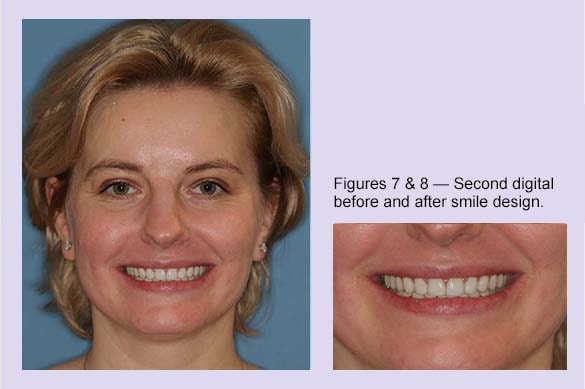
Figures 7 & 8 — Second digital before and after smile design.
This is the third of seven steps in designing the esthetics and function of the case. This is the second opportunity to get patient input and approval. To me this is the most important patient communication step. You need to translate your treatment plan and smile design into an after image that you can show the patient at the upcoming consultation appointment. There are several options one can use to accomplish this.
This can be done by you or a team member in your office by utilizing Photoshop or a variety of different software programs. Or it can be done the way I do it which is by sending the before 1:10 full face photo (fig 1) along with a very detailed description of the end result to Smile Art Communications (Tony Smith). I have been doing this for 10 years now and for me it is the central communication tool I use with my patients in discussing their end results.
I keep the consultation as simple as possible. I generally only use the digital image as my visual aide (figs 13 and 14). I keep the radiographs and models off to the side. I don’t want to take the patient to dental school I just want to show them how they will look.
If they do not like the outcome of the final image and I can’t see a way to accomplish what they are looking for I have found out before I started anything irreversible that I will not be able to meet their expectations. To me this part alone is worth gold.
If they are excited about the final image (usually this will be the case if you did a thorough new patient interview) you will know you can meet their expectations. To give you a little latitude I ask them: “If I come within 90% of what you see here will you be thrilled?” If they can’t say yes, continue finding out what they would like to see. The bottom line is you don’t move forward until they approve what they see. Sometimes this can take an additional image or two until they say “yes”.
After they approve the digital image we review the treatment plan that relates to that image. In this case both treatment plans were presented and the more conservative treatment plan stated above was accepted. Incorporating teeth whitening services was also discussed.

Figures 9 & 10 — Photos of the dental provisionals at the end of the provisional approval appointment. Note the very conservative preps showing
through the thin provisionals.
Once the treatment plan is approved the diagnostic wax-up is the next step. This is now your fourth part in designing the esthetics and function of the case. I will sometimes show the patient this step if I feel I need to get their continued approval. In this case we began her orthodontic treatment next.
Once the orthodontic treatment was completed new models were taken, new final digital image created and approved and then the diagnostic wax-up was made. When the diagnostic wax-up was fabricated the patient approved digital image and all smile design notes were followed to the letter (figs 14,15,16 and 17).
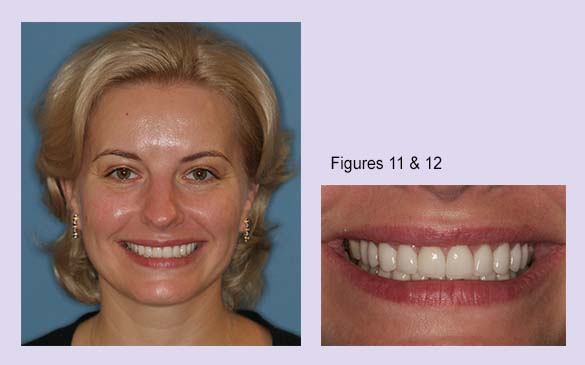
Figures 11 & 12 — Final photos at the one week follow up visit. Note the common theme from the first digital image the patient approved to the final result.
Also you can make a matrix as a guide to verify the gingival margin heights and zeniths positions and can alter them accurately if needed. Early on during the preparation phase make a trial provisional. 6 This will help you make accurate and conservative depth cuts so you don’t over or under prepare the teeth. Going back to the new patient interview, conservative tooth preparation was a priority for the patient.
In figures 9 and 10 you will see the completed shade A-1 upper provisionals. We based this decision off the approved digital image. As you can see this gives you another detail that can be approved before you go to the final restorations.
Figure 13 — The initial before and after digital image template shown to the patient at the first consultation appointment.
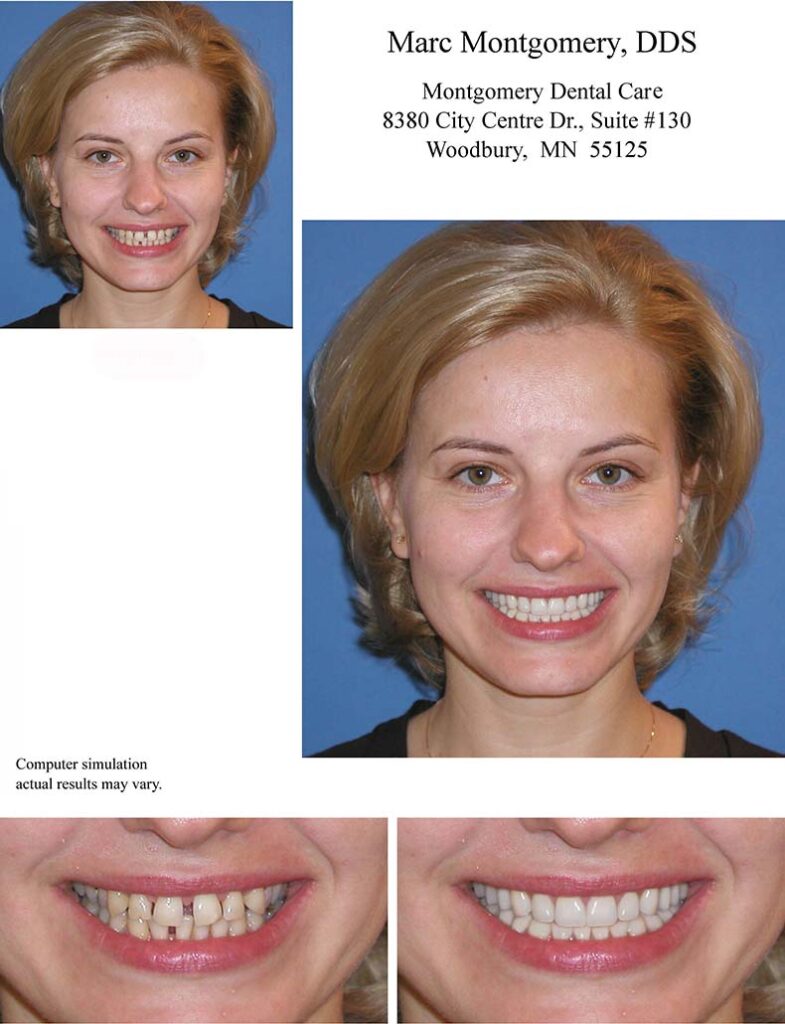
Now for you the hard part is done. You have an approved result and all the ceramist has to do is follow the0 model of the provisionals and photos. The key items to put in the written prescription are: material to be used, prep shade, final shade (and shade map if needed), surface texture, incisal characterization (refer to the shade ladder), any special patient considerations and most importantly follow the provisionals! 7
This is your sixth opportunity to fine tune the esthetics and function of the case. You get the input of your talented ceramist to really dial in the details. Don’t make any major changes at this point but he or she should help you with the little details that can really make the case become what the patient discussed in the new patient interview.
When the case is completed make sure it is back in your hands well before the try-in date. This gives you a chance to verify all the parameters that you and the patient want to see. Some of the basics are: final shade, length, width and contours of the restorations, no midline cants, no occlusal cants and proper emergency at the gingival margin. If any of these are not as you would like to see then recontour them yourself. If it is something you can’t do then send it back to the ceramist to make the needed changes. You want to go into the try-in appointment knowing that you have gotten the case set-up perfectly. The patient will sense your confidence and will more likely also be confident with the end result.
This is now the seventh opportunity to verify the esthetics. And the patient’s fifth time to approve their new smile design. If you followed all the previous steps discussed this appointment should be stress-free and a lot of fun. You have handled all the details in getting the patient’s feedback and approval throughout the process. You also are exuding confidence since you know in your heart there should be no surprises. Although, emphasize this is a try-in appointment only and if everything looks great to both of you then they will get them bonded in that day. This takes pressure off of you to not disappoint the patient and actually makes you look great if you do finish the case that day. It’s an opportunity to under-promise and over-deliver.
Once you have tried everything in and have determined you are happy with the results now give the patient the mirror and watch their eyes. This is the moment where you get a pit in your stomach or everyone is feeling really great. It’s the patient’s last approval opportunity and should only be a formality. To help confirm the shade I show them the photos of the provisionals with the shade tab and then I show them the same shade tab next their new restorations with try-in paste. 8 Since they most likely have already forgotten how the shade looked this will refresh their memory to what they had selected. Once you have concluded everyone is happy you are ready to bond in the case.
The seven steps to predictably meeting patient expectations in esthetic dentistry
(involving seven steps for yourself along with five patient input steps)
1. New Patient Interview: patient’s input your detailed notes and your initial thoughts on how this case should look.
2. Smile design: your input (figs 1,2,5,6 and 15)
3. Creating the before and after digital image: your’s and the patient’s input (figs 3,4,7,8,13 and 14)
4. Diagnostic wax-up: your’s, the ceramist’s and patient’s input (figs 15,16 and 17)
5. Provisionals: your’s and the patient’s input (Figs 9 and 10)
6. Fabricating the final restorations: your’s and the ceramist’s input
7. Try-in of the final restorations: your’s and the patient’s input
By the time you get to the final restorations the patient has given you four opportunities to guide you on what they want for a final result. This is why you will find the final visit to be so predictable and now enjoyable and rewarding.
Following the photos you will be able to see how the initial approved smile design was followed throughout the treatment. And as a result, a fairly complex case had become a straightforward sequence of steps that lead to an end result where the patient said: “That looks great! That is exactly what I expected”. Fortunately, I now understand what my father meant by the second pay. And as a result, I have enjoyed what this profession has given me. But I also have felt through all the benefits beautiful esthetic dentistry gives our patients I get to hear every week about how they feel my work has increased their self-confidence and self-esteem.
They tell me stories on how they have seen their relationships and success in their professions improve. I had a patient tell me the other day that the smile we made for him ten years ago probably added an additional million dollars in sales for his career. I joked with him and told him I apparently didn’t charge him enough. But in a different perspective I feel I did get paid an additional amount. It turned out to be as my father would now call it: “The Third Pay”.
1. Becker, I. Comprehensive Examination (C1 lecture/ workshop) Pankey Institute 2/01
2. Bolton, A. Book: People Styles at Work and Beyond
3. American Academy of Cosmetic Dentistry guide to Photography
4. Ivoclar Vivident IPS e.max Scientific Documentation
5. American Academy of Cosmetic Dentistry guide to Accreditation
6. Mechanic, E. Creative Smile Design: The Art of Temporization. Oral Health 2011: (4) 22-38
7. Hastings, J. Laboratory Communications: Essential Keys to Exceptional Results. American Academy of Cosmetic Dentistry J 1998: (4) 22-30
8. Nixon, R. The total spectrum from color modification to adhesive placement to seamless finishing (lecture/workshop) AACD national meeting Florida 5/03
Dr. Marc Montgomery received his DDS from the University Of Minnesota School Of Dentistry in 1986. For the last 26 years he has focused on high-quality, cosmetic-oriented family dental care in Woodbury, MN. He has been named Minneapolis/St. Paul Magazine’s Top Family and Cosmetic Dentist six consecutive times (2000, 2002,2005,2007,2009 and 2011). He is an accredited member of the American Academy of Cosmetic Dentistry, member of several dental organizations and past president and current board member of the Minnesota Academy of Cosmetic Dentistry.
The author would like to thank Denise Quitter CDT, Tim Averbeck CDT, Tom Quitter CDT and the rest of the team from Valley Dental Arts for their beautiful lab work that made this case so successful. Tony Smith at Smile Art Communications for his accurate digital images that are crucial in my patient communication. And my father Dr. Louis Montgomery, who has mentored me my whole life.OH
Dr. Marc Montgomery has focused on high-quality, cosmetic-oriented family dental care in Woodbury, MN, for the past 26 years. He has been named Minneapolis/St. Paul Magazine’s Top Family and Cosmetic Dentist six consecutive times (2000, 2002, 2005, 2007, 2009 and 2011). He is an accredited member of the American Academy of Cosmetic Dentistry, member of several dental organizations and past president and current board member of the Minnesota Academy of Cosmetic Dentistry. drmarc@montgomerydentalcare.com.
NOTE: This article, Predictably Meeting Patient’s Expectations in Esthetic Dentistry, was published at Oral Health Group on April 1, 2012 and is optimized by Hill Web Marketing.